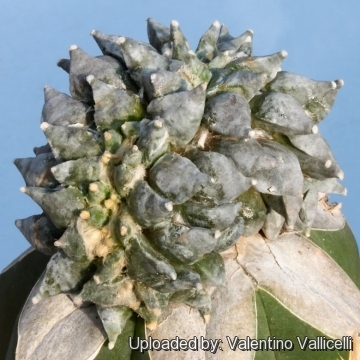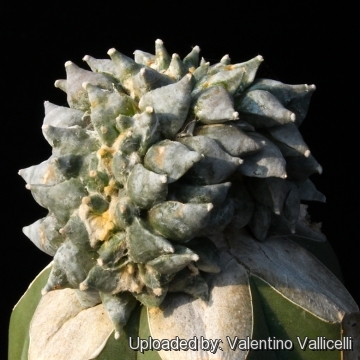Accepted Scientific Name: Ariocarpus retusus Scheidw.
Bull. Acad. Roy. Sci. Bruxelles 5: 492 (t. 1). 1838

Ariocarpus furfuraceus f. cristata Photo by: Valentino Vallicelli
Origin and Habitat: Garden origin (Nursery produced cultivar)
Synonyms:
See all synonyms of Ariocarpus retusus
back
Accepted name in llifle Database:Ariocarpus retusus Scheidw.Bull. Acad. Roy. Sci. Bruxelles 5: 492 (t. 1). 1838Synonymy: 31
Accepted name in llifle Database:Ariocarpus retusus subs. trigonus (F.A.C.Weber) E.F.Anderson & W.A.Fitz Maur.Haseltonia 5: 18. 1998 [1997 publ. 1998]Synonymy: 7
Cultivars
(11):
back
Description: Ariocarpus furfuraceus f. cristata (crested form), only deviate from the standard species for the stem which is fan shaped up to 30 cm (or more) long with age. The typical Ariocarpus furfuraceusSN|2079]]SN|2081]] (commonly known as the "Living Rock Cactus") is a solitary, slow-growing geophyte cactus, with tubercles slightly projecting above ground level. The large tuberous body is below the soil. It differs from the standard Ariocarpus retususSN|2081]]SN|2079]] only for its equilaterally triangular tubercles, all the other characteristics clearly show that they are conspecific.
Stem: fan shaped Grey-green, flattened, rounded on top, 10-25 cm in width and up to 30 cm or more in spread.
Tubercles: The distinctive characteristic of Ariocarpus furfuaraceus are the tubercles, which are equilaterally triangular shaped, divergent, convex or nearly flattened adaxially and often with shallow adaxial undulations or wrinkling, not fissured, 1,5-4 cm long, 1-3,5 cm wide, nearly as wide as long.
Areoles: At the tips of the tubercles, rounded, 1-5 mm in diameter.
Flowers: Diurnal, 4-5 cm in diameter, 2-4 2cm long, white to clear pink.
Root: Tap root.
Flowering time: Autumn.
Fruit: White, green, or rarely pinkish, 10-25 mm long, 3-10 mm in diameter.
Subspecies, varieties, forms and cultivars of plants belonging to the Ariocarpus retusus group
 Ariocarpus confusus Halda & Horáček: intermediates between Ariocarpus retusus and Ariocarpus trigonus flower color, white through to magenta, a color not found in any other populations. Distribution: Aramberri region.
Ariocarpus confusus Halda & Horáček: intermediates between Ariocarpus retusus and Ariocarpus trigonus flower color, white through to magenta, a color not found in any other populations. Distribution: Aramberri region. Ariocarpus elongatus (Salm-Dyck) Wettst.: has longer an narrower tubercles than Ariocarpus retusus. Distribution: Huizache, San Luis Potosí.
Ariocarpus elongatus (Salm-Dyck) Wettst.: has longer an narrower tubercles than Ariocarpus retusus. Distribution: Huizache, San Luis Potosí. Ariocarpus furfuraceus C.H.Thomps.: has equilaterally triangular shaped tubercles.
Ariocarpus furfuraceus C.H.Thomps.: has equilaterally triangular shaped tubercles. Ariocarpus furfuraceus f. cristata Frič: crested form.
Ariocarpus furfuraceus f. cristata Frič: crested form. Ariocarpus furfuraceus f. monstruosus hort.: Free branching plants with thinner elongated stems and copious production of wool. There are several different clones.
Ariocarpus furfuraceus f. monstruosus hort.: Free branching plants with thinner elongated stems and copious production of wool. There are several different clones.- Ariocarpus furfuraceus var. rostratus A.Berger: (Ariocarpus retusus var. furfuraceus ''rostratus'') Refers to plants with a more tapered apex to the tubercle.
 Ariocarpus retusus Scheidw.: (ssp. retusus) Widespread, flowers are cream or white, occasionally with reddish midveins.
Ariocarpus retusus Scheidw.: (ssp. retusus) Widespread, flowers are cream or white, occasionally with reddish midveins. Ariocarpus retusus f. cristata hort.: is a slow-growing crested cactus forming with fan shaped stems that will slowly forms brain-shaped cushion up to 3-12 cm high and 70 cm in diameter, or more.
Ariocarpus retusus f. cristata hort.: is a slow-growing crested cactus forming with fan shaped stems that will slowly forms brain-shaped cushion up to 3-12 cm high and 70 cm in diameter, or more. Ariocarpus retusus subs. horacekii Halda & Panar.: like Ariocarpus trigonus but smaller. Distribution: South of Matehuala, San Luis Potosí.
Ariocarpus retusus subs. horacekii Halda & Panar.: like Ariocarpus trigonus but smaller. Distribution: South of Matehuala, San Luis Potosí.- Ariocarpus retusus subs. jarmilae Halda, Horáček & Panar.: nomina nuda
- Ariocarpus retusus subs. panarottoi Halda & Horáček: Nomina nuda.
 Ariocarpus retusus subs. pectinatus Weisbarth: It has, dull pectinated spines already present in young specimens up to 1,2 to 2,0 mm long. The spines persist with the age. Areoles at the tips and extending on the upper side of the tubercles, elongated 2 to 20 mm long, wooly.
Ariocarpus retusus subs. pectinatus Weisbarth: It has, dull pectinated spines already present in young specimens up to 1,2 to 2,0 mm long. The spines persist with the age. Areoles at the tips and extending on the upper side of the tubercles, elongated 2 to 20 mm long, wooly.- Ariocarpus retusus subs. scapharostroides Halda & Horáček: Plants from the Villa Juarez region of SLP, it is characterized by erect angular tubercles, superficially reminiscent of Ariocarpus scapharostrus.
- Ariocarpus retusus var. sladkovskyi Halda & Kupčák
 Ariocarpus retusus subs. trigonus (F.A.C.Weber) E.F.Anderson & W.A.Fitz Maur.: (Ariocarpus retusus ssp. trigonus) Somewhat less widespread with long sharp tubercles twice as long as wide. The flowers are yellow (usually), white to pinkish white.
Ariocarpus retusus subs. trigonus (F.A.C.Weber) E.F.Anderson & W.A.Fitz Maur.: (Ariocarpus retusus ssp. trigonus) Somewhat less widespread with long sharp tubercles twice as long as wide. The flowers are yellow (usually), white to pinkish white. Ariocarpus retusus cv. Cauliflower: has a completely or partially warty skin that gives it an aspect of cauliflower.
Ariocarpus retusus cv. Cauliflower: has a completely or partially warty skin that gives it an aspect of cauliflower.- Ariocarpus retusus cv. Cauliflower King: This is a variant of cv. cauliflower with bigger, if not huge, tubercles giving an overall appearance rather globular.
 Ariocarpus retusus cv. Frumdosus: Unlike the type species, this cultivar has not convex, bulging tubers, but flat and smooth giving them an aspect of tetrahedron.
Ariocarpus retusus cv. Frumdosus: Unlike the type species, this cultivar has not convex, bulging tubers, but flat and smooth giving them an aspect of tetrahedron.  Ariocarpus retusus cv. Frumdosus brevituberosus
Ariocarpus retusus cv. Frumdosus brevituberosus Ariocarpus retusus cv. Frumdosus f. variegata
Ariocarpus retusus cv. Frumdosus f. variegata Ariocarpus retusus cv. Maruibo: Unlike the type species that has more or less triangular tubers, here they take a round shape and looks like small spheres ending with a large woolly areolae.
Ariocarpus retusus cv. Maruibo: Unlike the type species that has more or less triangular tubers, here they take a round shape and looks like small spheres ending with a large woolly areolae. Ariocarpus retusus cv. Maruibo Cauliflower: A pretty good combination of "Maruibo" and "Cauliflower" character.
Ariocarpus retusus cv. Maruibo Cauliflower: A pretty good combination of "Maruibo" and "Cauliflower" character. Ariocarpus retusus cv. Maruibo Pectinatus: is characterized by the swollen tubercles of "Maruibo" together with the very woolly and sometimes prickly central groove of "Pectinatus".
Ariocarpus retusus cv. Maruibo Pectinatus: is characterized by the swollen tubercles of "Maruibo" together with the very woolly and sometimes prickly central groove of "Pectinatus". Ariocarpus retusus cv. Mituibo: (a.k.a. cv. Three Finger or Tresfinger)The tip of each tubercles is split into three points as three fingers, a bit like a trident with a large central section and two smaller ones on each side.
Ariocarpus retusus cv. Mituibo: (a.k.a. cv. Three Finger or Tresfinger)The tip of each tubercles is split into three points as three fingers, a bit like a trident with a large central section and two smaller ones on each side. Ariocarpus retusus cv. Tama Botan: (a.k.a. Ariocarpus retusus var. major) It is a cultivated selection with very wide leaflike, divergent tubercles. The tubercles are 3,5 to 5 cm wide, and are as wide as long or wider in adult specimens.
Ariocarpus retusus cv. Tama Botan: (a.k.a. Ariocarpus retusus var. major) It is a cultivated selection with very wide leaflike, divergent tubercles. The tubercles are 3,5 to 5 cm wide, and are as wide as long or wider in adult specimens.
Bibliography: Major references and further lectures
1) Edward F. Anderson “The Cactus Family” Timber Press, 2001
2) Curt Backeberg “Cactus Lexicon” Sterling Publishing Company, Incorporated, 1978
3) David Hunt, Nigel Taylor “The New Cactus Lexicon” DH Books, 2006 ISBN 0953813444, 9780953813445
4) James Cullen, Sabina G. Knees, H. Suzanne Cubey “The European Garden Flora Flowering Plants: A Manual for the Identification of Plants Cultivated in Europe, Both Out-of-Doors and Under Glass” Cambridge University Press, 11/Aug./2011
 Ariocarpus furfuraceus f. cristata Photo by: Valentino Vallicelli
Ariocarpus furfuraceus f. cristata Photo by: Valentino Vallicelli Ariocarpus furfuraceus f. cristata Photo by: Valentino Vallicelli
Ariocarpus furfuraceus f. cristata Photo by: Valentino VallicelliCultivation and Propagation: It is not too difficult in a greenhouse, although grows slowly. It is often seen as a grafted plant but can grow on its own roots too.
Soil: Use mineral well permeable mineral soil with little organic matter (peat, humus).
Exposure: They need a good amount of light shade to full sun this help to keep the plants healthy, although slow growth.
Watering: Water sparingly from March till October (weekly during summertime, if the weather is sunny enough), with a little fertilizer added. Less or no water during cold winter months, or when night temperatures remain below 10° to prevent root loss. It is sensitive to overwatering (rot prone).
Fertilization: Feeding may not be necessary at all if the compost is fresh then, feed in summer only if the plant hasn't been repotted recently. Do not feed the plants from September onwards as this can cause lush growth which can be fatal during the darker cold months.
Hardiness: Keep perfectly dry in winter at temperatures from 5 to 15 degrees centigrade. (but it is relatively cold resistant and hardy to -10° C, or possibly colder for short periods) In the rest period no high atmospheric humidity!! (Temperature Zone: USDA 9-11)
Crested growth: Unlike 'monstrose' varieties of plants, where the variation from normal growth is due to genetic mutation, crested growth can occur on normal plants. Sometimes it's due to variances in light intensity, or damage, but generally the causes are unknown. A crested plant may have some areas growing normally, and a cresting plant that looks like a brain, may revert to normal growth for no apparent reason. If you have any of the crested part left you need to remove the normal growth and leave the crested part behind this will need to be done regularly.
Propagation: Grafting or cuttings. Plants are usually grafted onto column-shaped cacti but proved to be able to produce their own roots if degrafted. Cuttings will take root in a minimum temperature of 20° C (but better in hot weather). Cuttings of healthy shoots can be taken in the spring and summer. Cut the stem with a sharp, sterile knife, leave the cutting in a warm, dry place for a week or weeks (depending on how thick the cutting is) until a callus forms over the wound. Once the callus forms, the cutting may be inserted in a container filled with firmed cactus potting mix topped with a surface layer of coarse grit. They should be placed in the coarse grit only; this prevents the cut end from becoming too wet and allows the roots to penetrate the rich compost underneath. The cuttings should root in 2 to 6 weeks. Large crested piece must be placed on the soil surface without burying the plant base down in the soil.












